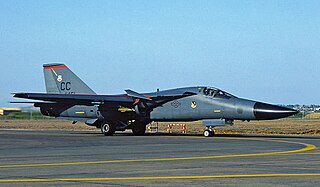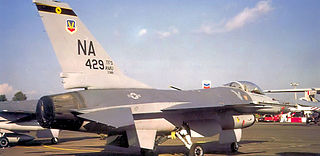See also
- VFC-111, U.S. Navy fighter squadron
- VF-111, U.S. Navy fighter squadron
- VMF-111, U.S. Marines fighter squadron
- F3 (disambiguation)
- F11 (disambiguation)
- F1 (disambiguation)
The General Dynamics F-111 Aardvark is a U.S. jet fighter-bomber aircraft.
F111 or variation, may also refer to:

The Grumman F-14 Tomcat is an American carrier-capable supersonic, twin-engine, two-seat, twin-tail, variable-sweep wing fighter aircraft. The Tomcat was developed for the United States Navy's Naval Fighter Experimental (VFX) program after the collapse of the General Dynamics-Grumman F-111B project. A large and well-equipped fighter, the F-14 was the first of the American Teen Series fighters, which were designed incorporating air combat experience against MiG fighters during the Vietnam War.

General Dynamics Corporation (GD) is an American publicly traded, aerospace and defense corporation headquartered in Reston, Virginia. As of 2020, it was the fifth-largest defense contractor in the world by arms sales, and 5th largest in the United States by total sales. The company is a Fortune 100 company, and was ranked No. 94 in 2022.

The General Dynamics F-111 Aardvark is a retired supersonic, medium-range, multirole combat aircraft. Production models of the F-111 had roles that included attack, strategic bombing, reconnaissance and electronic warfare. Developed in the 1960s by General Dynamics, the F-111 entered service in 1967 with the United States Air Force (USAF). The Royal Australian Air Force (RAAF) also ordered the F-111 and began operating the F-111C in 1973.

The McDonnell Douglas/General Dynamics A-12 Avenger II was a proposed American attack aircraft from McDonnell Douglas and General Dynamics. It was to be an all-weather, carrier-based stealth bomber replacement for the Grumman A-6 Intruder in the United States Navy and Marine Corps. Its Avenger II name was taken from the Grumman TBF Avenger of World War II.

The Douglas F6D Missileer was a proposed carrier-based fleet defense fighter designed by Douglas Aircraft Company in response to a 1959 United States Navy requirement. It was designed to be able to loiter for extended periods at a relatively long distance from the Navy's aircraft carriers, engaging hostile aircraft 100 miles (160 km) away with its powerful radar and long-range missiles. Since the enemy would be fired on long before they reached visual range, the aircraft had little dogfighting capability and was strictly subsonic. When doubts were expressed about the Missileer's ability to defend itself after firing its missiles, the value of the project was questioned, leading to its cancellation. Some of the Missileer's systems, primarily the engines, radar, and missiles, continued development in spite of the cancellation, eventually emerging on the ill-fated General Dynamics–Grumman F-111B and successful Grumman F-14 Tomcat years later.

Tactical Air Command (TAC) is an inactive United States Air Force organization. It was a Major Command of the United States Air Force, established on 21 March 1946 and headquartered at Langley Air Force Base, Virginia. It was inactivated on 1 June 1992 and its personnel and equipment absorbed by Air Combat Command (ACC).

The General Dynamics–Grumman EF-111A Raven is a retired electronic-warfare aircraft designed to replace the EB-66 Destroyer in the United States Air Force. Its crews and maintainers often called it the "Spark-Vark", a play on the F-111's "Aardvark" nickname.
The British Commonwealth Far East Strategic Reserve was a joint military force of the British, Australian, and New Zealand armed forces. Created in the 1950s and based in Malaya, the FESR was conceived as a forward defence point for Australia and New Zealand, while protecting Commonwealth interests in the Southeast Asian region from both internal and external communist threats. The FESR was made up of an infantry brigade and an aircraft carrier group, supported by squadrons of aircraft.
HMNZS Waikato (F55) was a Leander Batch 2TA frigate of the Royal New Zealand Navy (RNZN). She was one of two Leanders built for the RNZN, the other being the Batch 3 HMNZS Canterbury. These two New Zealand ships relieved British ships of the Armilla patrol during the Falklands conflict, freeing British ships for deployment.
Under United Nations Security Council Resolution 678, a coalition of 35 countries, led by the United States, fought Iraq in the Gulf War from 1990–1991.

The 428th Fighter Squadron is part of the 366th Fighter Wing at Mountain Home Air Force Base, Idaho. Currently, it operates F-15SG Strike Eagle aircraft conducting formal training missions to qualify Republic of Singapore Air Force crew in the F-15SG in a program titled Peace Carvin V.

The 832nd Air Division is an inactive United States Air Force organization. Its last assignment was with Tactical Air Command, (TAC) assigned to Twelfth Air Force at Luke Air Force Base, Arizona, where it was inactivated on 1 October 1991.

The General Dynamics–Grumman F-111B is a long-range carrier-based interceptor aircraft planned as a follow-on to the F-4 Phantom II for the United States Navy (USN).

The 388th Electronic Combat Squadron is an inactive United States Air Force unit. Its last assignment was with the 366th Fighter Wing, based at Naval Air Station Whidbey Island, Washington.

The 474th Tactical Fighter Wing is an inactive United States Air Force unit. Its last assignment was at Nellis Air Force Base, Nevada, where it trained combat-ready aircrews and maintained a rapid-reaction capability to execute fighter attacks against enemy forces and facilities world-wide in time of crisis. A World War II predecessor unit, the 474th Fighter Group, was a Ninth Air Force combat unit of the Army Air Corps which fought in the European Theater. During its operational lifetime, the 474th Fighter Bomber Wing was engaged in combat operations during the Korean War and the 474th Tactical Fighter Wing was engaged in combat operations during the Vietnam War. Through its history, the 474th Wing flew the F-84G, F-86H, F-100D, F-111A, F-4D, and F-16A/B. The 474th Tactical Fighter Wing was inactivated on 30 September 1989.

The General Dynamics F-111C is a variant of the F-111 Aardvark medium-range interdictor and tactical strike aircraft, developed by General Dynamics to meet Australian requirements. The design was based on the F-111A model but included longer wings and strengthened undercarriage. The Australian government ordered 24 F-111Cs to equip the Royal Australian Air Force (RAAF) in 1963, but the aircraft were not delivered until 1973 because of long-running technical problems. During 1979 and 1980 four of these aircraft were converted to the RF-111C reconnaissance variant. Four ex–United States Air Force (USAF) F-111As were purchased by Australia and converted to F-111C standard in 1982 to replace F-111Cs destroyed during accidents. Australia also operated 15 F-111Gs between 1993 and 2007, mainly for conversion training. The RAAF retired its remaining F-111Cs in December 2010. In Australian military and aviation circles, the F-111 Aardvark was affectionately known as the "Pig", due to its long snout and terrain-following ability.

The 429th Electronic Combat Squadron is an inactive United States Air Force unit. It was first activated in August 1943 and participated in conflicts including World War II, the Korean War, the Cuban Missile Crisis, and the Vietnam War.

The General Dynamics F-111K was a planned variant of the General Dynamics F-111 Aardvark medium-range interdictor and tactical strike aircraft by General Dynamics, to meet a requirement for such an aircraft for the Royal Air Force.

Royal Air Force Upper Heyford or more simply RAF Upper Heyford is a former Royal Air Force station located 5 miles (8 km) north-west of Bicester near the village of Upper Heyford, Oxfordshire, England. In the Second World War the airfield was used by RAF Bomber Command. During the Cold War, Upper Heyford was one of the former RAF bases chosen to house the United States Air Force Strategic Air Command (SAC) nuclear-capable bombers on 90-day TDY deployments until 1959, SAC Reflex Alert deployments from 1959 until 1965, from 1966 United States Air Forces in Europe (USAFE) tactical reconnaissance aircraft, and from 1970 General Dynamics F-111 Aardvark strike aircraft.